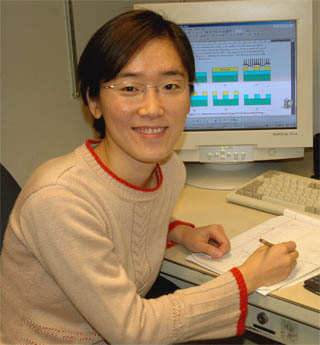
Department
of Chemical Engineering
Room 66-217
Massachusetts Institute of Technology
77 Massachusetts Avenue
Cambridge, MA 02139-4307 USA
Telephone (617) 253-6586
Email: wguo@mit.edu

Wei Guo
Graduate Research Assistant
B.S., Chem. Engr., Tsinghua University, PRC, 2002M.S., Chem. Engr., Tsinghua University, PRC,, 2004
Research Interests
Modeling of surface kinetics and feature profiles from directional plasma etching.
In the production of microelectronic circuits, directional plasma etching has long played a major part. More efficient etching, however, will rely on quicker and more accurate modeling of the three elements of the plasma etch process: 1) plasma modeling, 2) surface kinetics modeling and, 3) profile simulation.
My research centers on surface kinetics and feature profile modeling. Having first an understanding of the physical surface kinetics will decide the predictive accuracy of any subsequent feature profiles model. So in our kinetics modeling, the etching rate, etching selectivity, surface concentration and reaction product fluxes will first be simulated and then incorporated into our profile simulator (combined with the material qualities and topology of the substrate surface) to help predict the etched feature profile. In the first stage, our work aims to create a surface model that can quantitatively predict the typical physio-chemical processes in the plasma etching, including physical sputtering, ion enhanced etching and spontaneous reaction, as well as the ion incorporation and neutral adsorption. Additional characteristics we hope to study and include are the dependence of etching/deposition yield on the ion energy, ion incident angle, and neutral-to-ion flux ratio.The model we hope to create depends on our lab's prior simulation done on Si etching with chlorine plasmas and will modify that model to include the more desirable, but more complicated, silicon dioxide etch by fluorocarbon plasmas. The result should yield the necessary kinetics data for an accurate feature profile representation and thus help better control quality plasma etching in production.
I was originally interested in plasma science because it is used in fabricating so many sophisticated devices such as memory chips, ipods, and satellite communication electronics. But I was uncertain, and so curious, as to how any particular tool of chemical engineering contributes to the plasma processing of microelectronics. After diving into the plasma etching literature, I found out: chemical kinetics on the wafer surface is one of the central studies for microelectronic fabrication. So chemical engineers provide a crucial input for creating the chips used in all our fabulous devices. And my interest has grown as a result. My thesis work centers on kinetics of the etched surface and its feature profile in computer simulation and will complement experimental work already done by other members of the Sawin Squad. It the future it may involve some reactor studies.